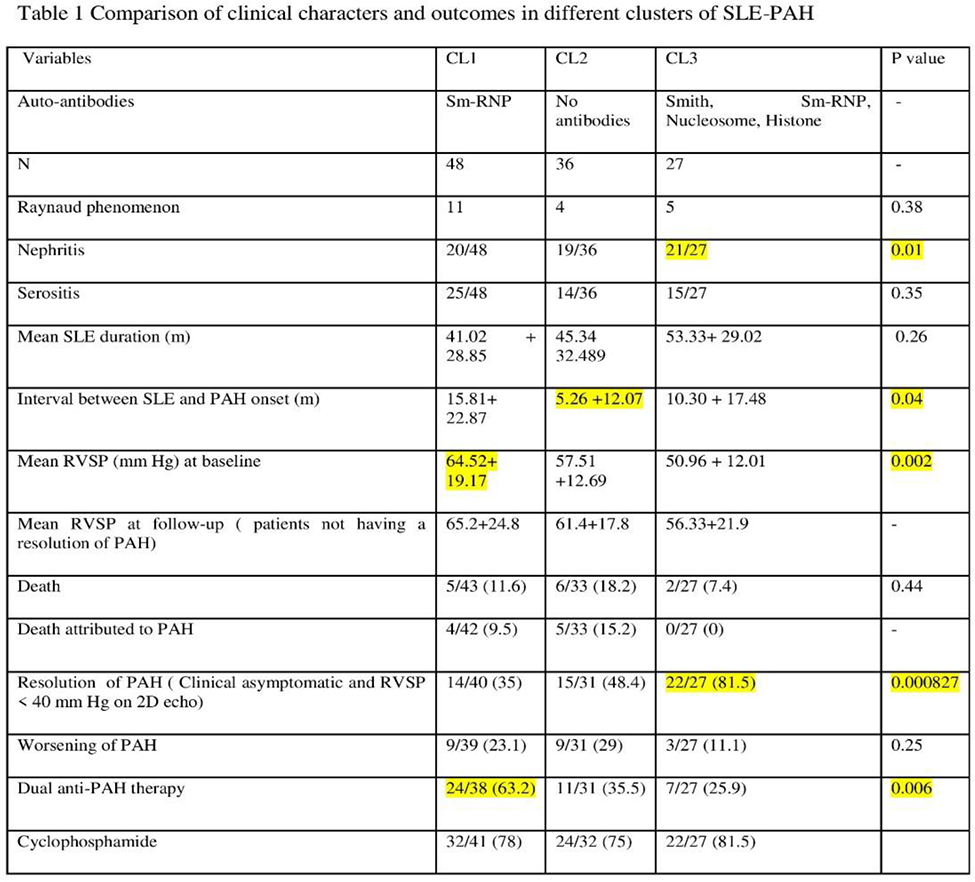

Background: Pulmonary arterial hypertension (PAH) is a severe complication that is frequently overlooked in patients with systemic lupus erythematosus (SLE). The clustering of SLE-PAH is garnering attention as it is believed to have distinct underlying mechanisms and responses to treatment. Therefore, this study aims to classify SLE-PAH into various clusters based on auto-antibody profiles and examine these clusters’ long-term outcomes.
Objectives: The main aim of this study was to categorise SLE-PAH patients into different clusters based on their autoantibody profiles and evaluate the long-term outcomes, including mortality, improvement or worsening of PAH over a 12-month period.
Methods: This study was conducted as a bidirectional hospital-based investigation. We included patients who met ACR 1997 or SLICC 2012 classification criteria for SLE and displayed clinical symptoms and signs of PAH and were confirmed with a 2D-echocardiographic diagnosis, RVSP > 40 mm Hg. We also performed an autoantibody profile assessment including Euroimmun ANA blot, complement and anti-cardiolipin antibody tests. The outcomes we analysed included death, PAH resolution, anti-PAH therapy increment, and RVSP measurements at the end of the 12-month follow-up period. Clustering was done by K means cluster analysis.
Results: A total of 111 SLE-PAH patients were included with female: male 106: 5 and a mean age of 28.9±9.2 years. Three distinct clusters were generated– Cluster 1 had predominant Sm-RNP positivity with the maximum number of patients (n= 48), followed by Cluster 2 (no definite auto-antibody, n= 36) and Cluster 3 having multiple autoantibody positivity (Smith, Sm-RNP, Nucleosome and Histone). Anticardiolipin antibody and Ribosomal P protein failed to form any cluster. Over a follow-up period of 12 months, 13 patients succumbed, with the highest number in cluster 1 (clinically not significant). Cluster 2, with no definite antibodies, presented with PAH earlier compared to the other two clusters (p- 0.01). Improvement of PAH (RVSP < 40 mm Hg) with subsequent withdrawal of anti-PAH medication was statistically significant in cluster 3 (p- 0.00), while higher baseline mean RVSP (p=0.04) and use of dual anti-PAH therapy (p- 0.000) were statistically significant in cluster 1.(Table 1)
Conclusion: This study is the first to focus on long-term follow-up of SLE-PAH through cluster-based analysis. Sm-RNP antibody contributes to a more severe form of the disease requiring dual anti-PAH therapy. Interestingly the presence of multiple antibody positivity appears to be associated with a better prognosis in SLE-PAH with the majority of patients experiencing a resolution of PAH.
REFERENCES: [1] Mizus M, Li J, Goldman D, et al. Autoantibody clustering of lupus-associated pulmonary hypertensionLupus Science & Medicine 2019;6:e000356.

Acknowledgements: NIL.
Disclosure of Interests: None declared.